 | ||
Street poster in Wein.
  |
We left Wein early. Caroline was feeling sick to her stomach. It was a Sunday morning so all the pharmacies were closed.
"The Germans take their time off seriously," cautioned Caroline.
Our train was not leaving for 90 minutes. So number one and I took off wandering through the old streets, looking at graffiti, trying to translate, reading the anarchist posters, and broadsheets, about refugees and Nazis, the current preoccupation of Europe. Everyone is a little anxious about what will happen with the illiberal wave grasping the world from Russia and the UK, the US to Hungry. Old men were standing around. A brothel had closed its doors for the day. The only thing open were the churches, that looked empty.
So we walked and looked around.
Finally, we make our way back to the station.
We bought our tickets for Budapest two days prior. But they could not sell us seat reservations. So, we found ourselves jockeying for seats with backpackers from all over Europe, everyone sitting on top of each other. Finally, we found our way to the meal car, where Austrian swim team sat drinking beer, holding all the seats. Still, everyone was in good spirits as we watched the country pass us by, everyone looking out, playing cards, etc. Finally, a young woman offered to share her sea with the little one and other opened up.
We all played cards together.
She told us about her studies in Economics.
I asked if she was a socialist or a supporter of neoliberal economics. The latter she said. The pointed out that she likes Austria more than Hungry, and doesn't like that Germany let in so many refugees.
No one wants to be a refugee, I thought.
"You scratch the surface and people's biases come out here," Caroline observed, reveling in the cattle car feeling of traveling East as we were doing.
Finally, two and a half hours later, we arrived in the Central train station in Budapest.
"Welcome to the old USSR," Caroline smiled when we got out.
Well, Eastern Block.
I went to change money out of Euros and Caroline checked our train tickets.
The station felt immediately old world. The post 1989 vibe that has grasped other countries in the East does not seem to have grasped Budapest.
Old men were showing us pictures of their apartments saying we could stay there.
And we started walking the three k to our hotel down Rakoczi toward our hotel on the Buda bank of the Danube, passing a few porn shops, cafes and a group of French college kids playing rave music.
"The party follows dad," smiled Number One. Some days i'm still cool in their minds, but usually not.
The gloss of Wein was nowhere to be seen - just a livable city, with trams passing to and from, as people seemed to enjoy their city.
Finally, we got to the Danube, walking over the Szecheni bridge, looking at the majestic river below.
Our hotel, the Gellert Bath, felt like a model for the Grand Budapest Hotel, with 1970's decorum.
Our rooms overlooked the river.
"It all starts with Monsieur Gustav," we repeated over and over.
The next three days, we'd meander around the city and go to the spas. The Gellert required we wear our bathrobes and swim caps to and from the baths. The wave pool inside the main outside pool at the Gellert bounced our delighted bodies to and from. We popped into the hot pools, the saunas, back into the cool, over and over again, old men and young women, kids, parents, lots and lots of people enjoying the waters together.
I love the look of people chilling by the pool.
The next day, we bought tickets for the tram and made our way up to Hero's Square. We'd seen enough museums for a lifetime in Wein. So this was going to be a light trip. But the remnants of the past were everywhere. At the square, we took in the majestic statue of the Seven Chieftains of the Magyars. The remains of Imre Nagy, the leader of the non-Soviet appointed government in 1956 who was killed, were also buried there.
But enough history for the day.
We made our way to the Szechenyi bath, a majestic complex of baths by the zoo. We'd spend the hot day bouncing around the waters there. People live well here.
Finishing our majestic day, we were going to meet friends in the Jewish Quarter for dinner. Police were everywhere at the park as we left. The subway was not working. So we walked down to the next stop on Andrassay, the main thoroughfare. Full of majestic old homes the walk felt great, more and more police with each block and subway closure.
"What is going on?" i asked a man in a restaurant, police tape blocking people from the road.
"The president is coming," one of the waiters explained.
Two police walked up to me and ushered me to the other side of the sidewalk. I pulled out my camera, taking more pictures. Police screaming at people walking on the sidewalks - it felt just like home. I took more photos. Menacing police screamed at more and more people, pointing their fingers, pulling out their batons. Ah the joys of those with a small bit of authority, exercising it with abandon. The whole world is watching. Police helicopters zoomed above us, motorcycles and a motorcade zoomed past us, and the the police screamed.
Finally, we could cross the street and get to dinner.
Our friend is at the university here, where the the illiberal turn in Hungry has inspired him to contemplate leaving. President Fidesz has picked a fight with George Soros, who funded the university where he works. And the president wants to restrict the education here.
"Hungry was just out of one dictatorship," he lamented. "He loves Trump and Putin."
So we talked and walked and took in a beer garden and made our way home along the wonderful tram.
"Its an edu vacation," Caroline explained to the kids the next day as we planned to go to the Terror Museum and the Shoes on the Danube Bank, a monument to the people killed along the Danube, many Jews, who were told to take off their shoes before they were shot along the river, so their bodies would be pulled away the water.
"If you were killed wouldn't you want someone to remember you," Caroline explained.
Our first stop was at the Terror Museum we'd seen the day before, with memorial to the ideas and dreams of a common future lost with the Iron Curtain and the Berlin Wall. Around Europe, people study the lessons of creating walls. Walls never work. But sadly, our current US leader has no interest in the lessons of this past. Instead he harbors plans to put up more walls.
"Growing up in Texas, I never ever heard anyone talk about feeling threatened by Mexico," I recalled with Caroline, "never." Today, I'm embarrassed for my country.
Walking in front of the museum, one encounters a granite building, lined with photos of people who perished or were tortured here, as the city expelled and killed Jews, as well as endured the Nazi and Soviet Occupations.
The museum rational is simple:
With a group of German students, we walked inside past the tank used to crush the uprising of 1956 and the resistance movements to the Nazis and Soviets. The museum begins with videos of "March 19th 1944, the day of Nazi occupation, the day when Hungary lost its independence. In the next hall, the Passage of the Hungarian Nazis (Arrow Cross Party)..." mark the beginnings of totalitarian rule, which gripped the people here. Inside the building, people were interrogated, tortured, and perished. There was little winning. Leaders were turned on, forced to confess, peasants attacked, all with little logic.
Its stomach turning to watch and imagine being there.
Later, we sat talking wondering about all that we know about the left. Why do humans resort to such manifestations of power. As one man pointed out in the museum, there is no forgiving. They shot people who had different opinions, 16 and 18 year old kids, left dead. That was their socialism.
And what of the intellectuals we love, such as Lukacs, who failed to condemn Stalin? Did he even have a choice? And what is one to think when the philosophy one dedicates his life to is used to justify a power play, supported by gulags, torture, and repression?
We talked about the anarchists of history who opposed this, as well as assasinated leaders, the left who failed to condemn Stalin, and the ascendant right. Its a scary world.
Finishing lunch in the beer garden we made our way to the Shoes on the Danube Bank monument. Standing, we looked at the shoes memorializing the victims, wondering about their final moments, looking at the shoes they were forced to take off before they were shot.
Later, we spend the afternoon at the Gellert Bath, feeling good to be alive, but full of mixed emotions. Its a lot to take in. There is a lot of cruelty. In the US, congress is busy gutting funding for healthcare. Cruelty and greed are everywhere.
But so are heros. Walking later that night, I heard violins and gypsy music in the Jewish Quarter. Kids sat on the bridge, eating along the Danbube, just trying to enjoy their lives for a moment in time, in their majestic city.
Number two and I walked and talked.
"Dad, I think we spent too much time in Vienna. I really like it here," she continued. "Its just beautiful, full of people. It feels livable."
I do adore Budapest. I'm sorry for the cruelties of its past. I hope it will be ok.
 |
| Scenes from a wonderful two days in Budapest. |






























































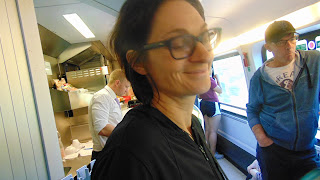






































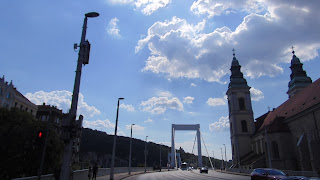








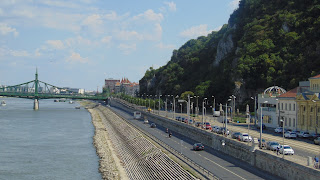









































































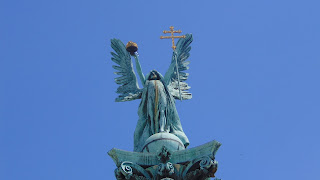












































































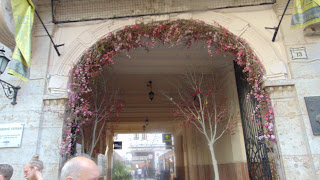
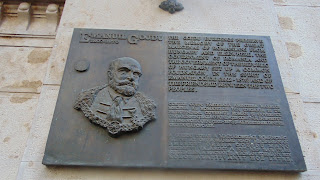














































































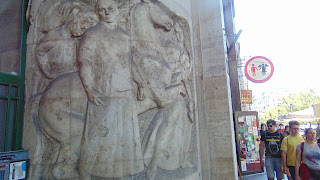



















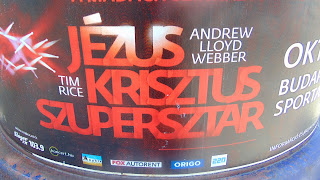



























This comment has been removed by a blog administrator.
ReplyDeleteThis comment has been removed by a blog administrator.
ReplyDelete